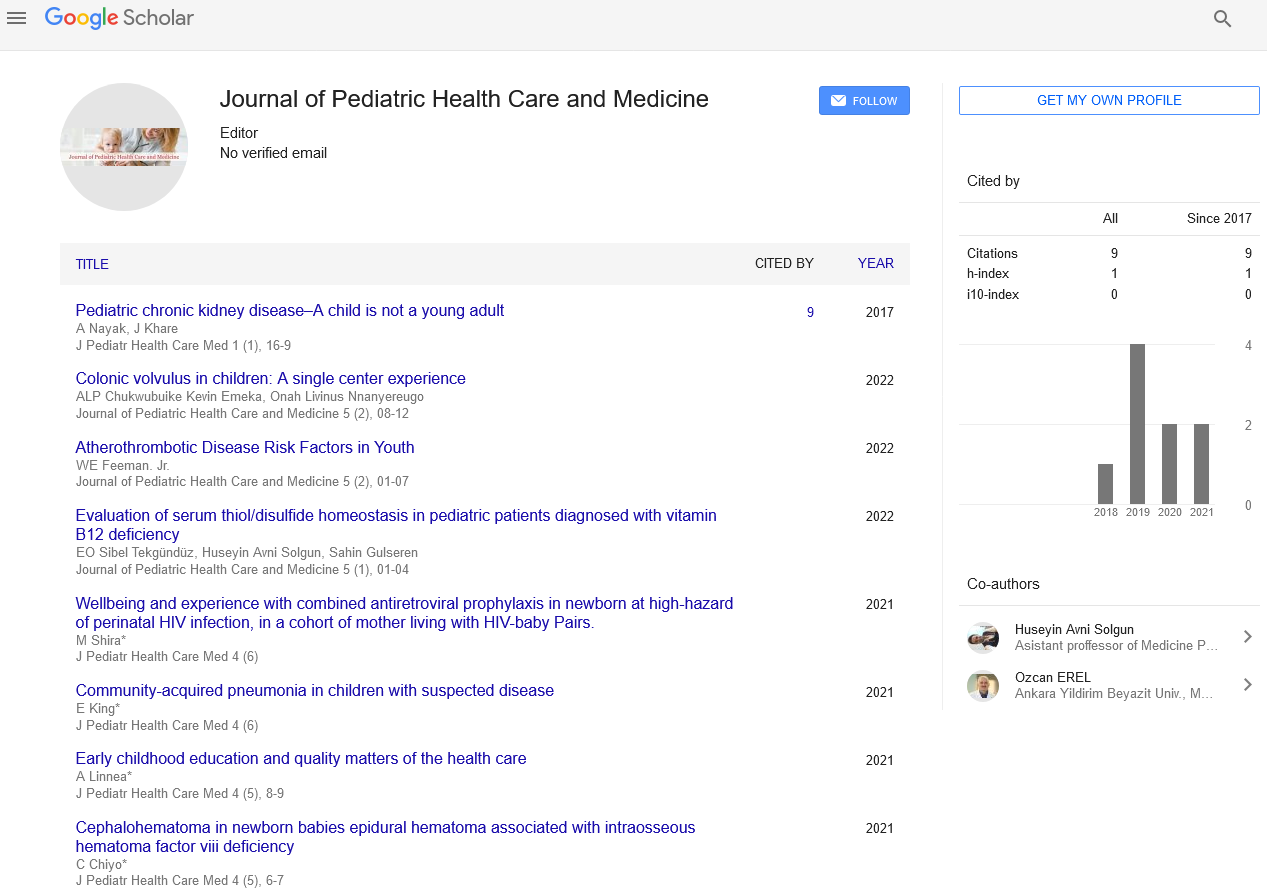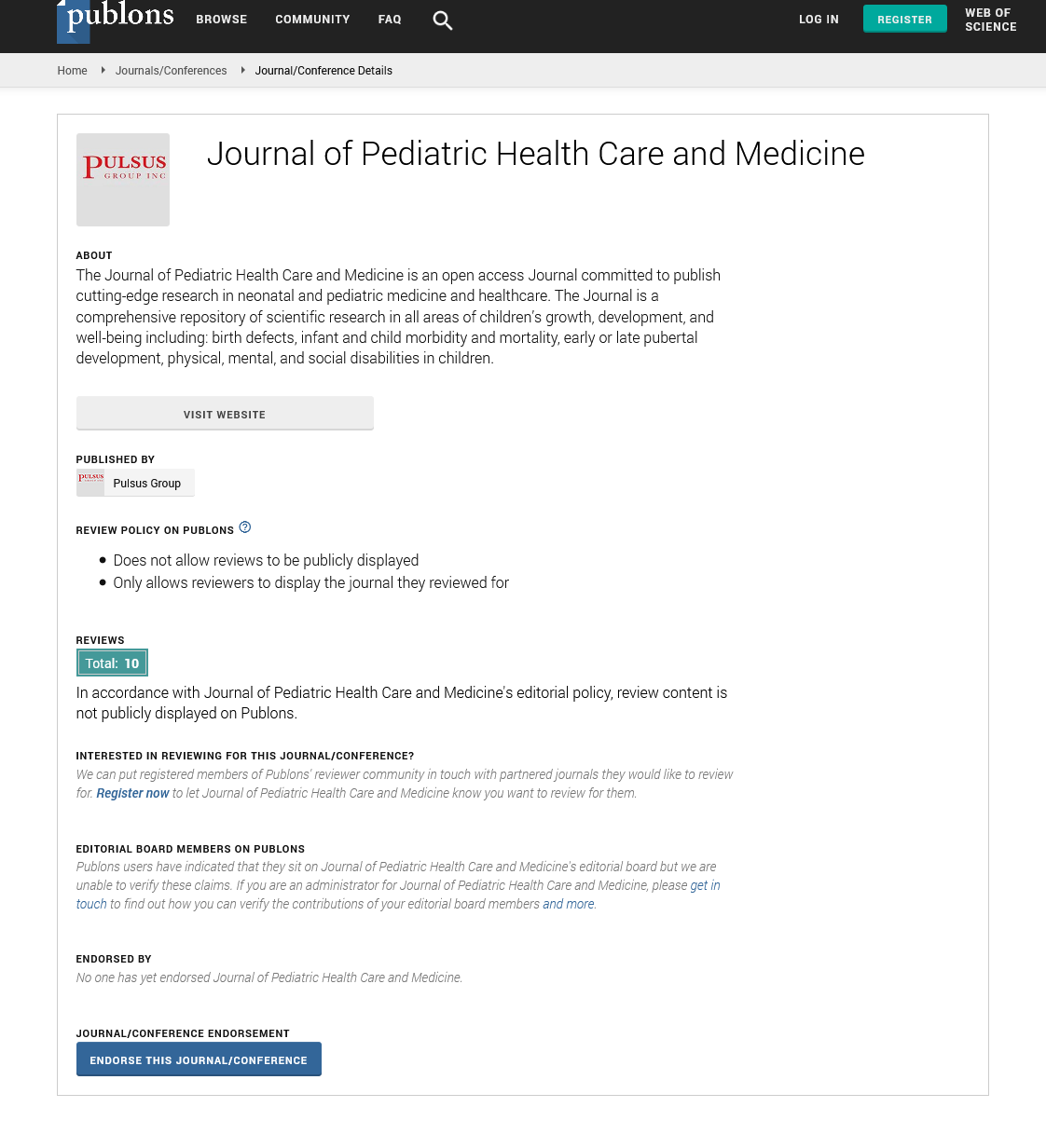Short assessment on functional nausea in children
Received: 10-Mar-2022, Manuscript No. puljphcm-22-4467; Editor assigned: 14-Mar-2022, Pre QC No. puljphcm-22-4467; Accepted Date: Mar 28, 2022; Reviewed: 21-Mar-2022 QC No. puljphcm-22-4467; Revised: 25-Mar-2022, Manuscript No. puljphcm-22-4467; Published: 30-Mar-2022, DOI: 10.37532/puljphcm.2022.5(2).26-27
Citation: Woods M. Short assessment on functional nausea in children. J Pedia Health Care Med. 2022; 5(2):26-27.
This open-access article is distributed under the terms of the Creative Commons Attribution Non-Commercial License (CC BY-NC) (http://creativecommons.org/licenses/by-nc/4.0/), which permits reuse, distribution and reproduction of the article, provided that the original work is properly cited and the reuse is restricted to noncommercial purposes. For commercial reuse, contact reprints@pulsus.com
Abstract
Functional nausea is a condition that adversely reduces an individual's quality of life. It was only recently included in the pediatric list of gut-brain connection diseases. The majority of the time, only a few tests are required to detect functional nausea. Hypnotherapy has been demonstrated to be a very effective treatment, and there are a number of additional medical and non-medical approaches that may aid some subgroups of chronic nausea patients.
Keywords
Nausea; Pediatrics; Hypnotherapy; Functional nausea
Introduction
There are few symptoms as painful as nausea; just ask women suffering from hyperemesis gravidarum, who experience a severe decline in physical and social health. It's not unexpected that nausea is a common reason for pediatric gastroenterologists to be consulted. Nausea, like constipation, stomach pain, diarrhea, and most other gastrointestinal symptoms, can be a symptom of an underlying intestinal or extra-intestinal disease, or it might be "functional." Functional diseases, which are caused by a breakdown in brain-gut communication, have recently been termed Disorders of Gut-Brain Interaction (DGBI). However, whereas the terms "functional abdominal pain" and "functional constipation" have long been in use, "functional nausea" has just recently been defined and accepted.
Clinical Presentation
The lack of reliable measurement instruments, defined diagnostic criteria, and treatment protocols makes functional nausea particularly difficult to address and explore. In the true spirit of a bio-psychosocial paradigm, its etiology is multifaceted and likely involves autonomic, cerebral, and gastrointestinal pathways, as well as psychological comorbidities. The reported prevalence rates of chronic or intermittent nausea in school children range from 15% to 23%, with the majority of these children suffering from functional nausea. Nausea appears to be more common in children with DGBI who have pain-related illnesses, with 53% prevalence, and in those who have functional constipation. Nausea appears to be more common in girls and children who attend private schools, and there is evidence that more frequent nausea leads to more missed school days and inability to participate in home activities. Nausea is a common symptom in episodic DGBI such abdominal migraines and Cyclic Vomiting Sickness (CVS), and many nausea patients meet the criteria for Postural Orthostatic Tachycardia Syndrome (POTS). The symptom of chronic nausea peaks in around half of all patients in the morning. Nausea is a common symptom of gastric dysfunction, with a change in gastric electrical rhythm leading to gastroparesis or problems in fundic accommodation, and nausea triggered by chemo- and mechano-receptors in the abdomen. Signals conveyed to the Central Nervous System (CNS) may be magnified or reduced based on a person's personal history, environment, and psychiatric comorbidities. These signals appear to be regulated in part by the limbic system. Other physiologic changes associated with nausea include diaphoresis, eye blinking, salivation, palpitations, and pallor. Greater sympathetic and decreased parasympathetic Autonomic Nervous System (ANS) modulation appears to be linked to increased nausea perception.
Diagnosis
Both adults and children have been studied to see if there is a link between nausea and stomach dysfunction. Nausea was the only symptom connected to delay stomach emptying in one study and the third most prevalent symptom (after vomiting and abdominal pain) in the other. Because of the overlap in symptoms between gastroparesis and functional dyspepsia, studies of stomach emptying can be challenging to interpret. It is generally known that gastric emptying levels do not predict the severity of symptoms or treatment success. However, when the objective measurement of stomach emptying after a substantial meal produces an aberrant value, patients and their families typically find confirmation of the symptom. When multiple stomach emptying studies are performed and the results differ, the abnormal result is invariably trusted more. Finally, to add to the confusion, it has been observed that nausea can be a symptom of rapid stomach emptying, which includes symptoms that are similar to gastroparesis.
Treatment
Hypnotherapy was compared to regular medical treatment in a large study of children with functional dyspepsia or functional nausea. Over the course of three months, a licensed hypnotherapist delivered six 50–60 minute sessions. The medical treatment group saw their treating pediatrician six times over the course of three months. Pediatricians were told to utilize a stepwise approach that included dietary changes, lifestyle adjustments, and a series of drugs given in a precise order. The research children also received six 30-minute sessions of supportive treatment to compensate for the patient–therapist time in the hypnosis group. The study found that both hypnosis and medication treatment were beneficial in lowering chronic nausea symptoms, with hypnotherapy being more effective within the first six months after treatment, particularly in children with functional nausea. This study contributes to a growing body of evidence demonstrating that Cognitive Behavioral Therapies (CBT) and other brain-directed therapies are highly effective interventions in children with DGBI who have pain. In fact, I am not aware of any unfavorable studies involving CBT in children with DGBI who had pain as their primary symptom. And, because the study employed four different drugs, herbal supplementation, and dietary suggestions, one might easily argue that the "normal" medical treatment used in this study was actually an "augmented" approach.






